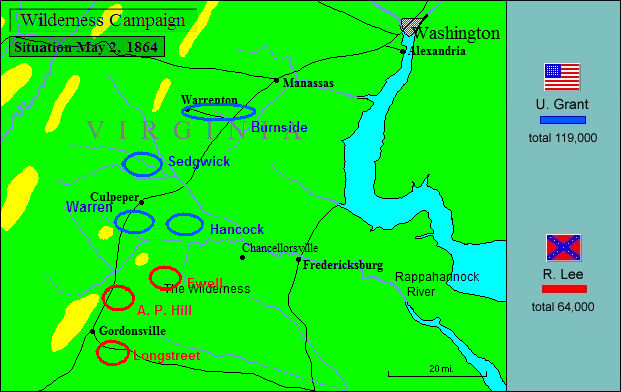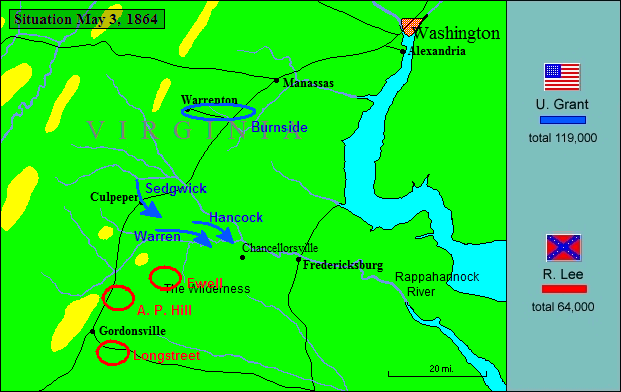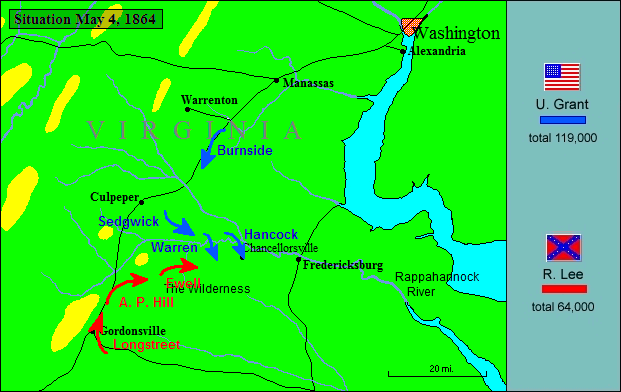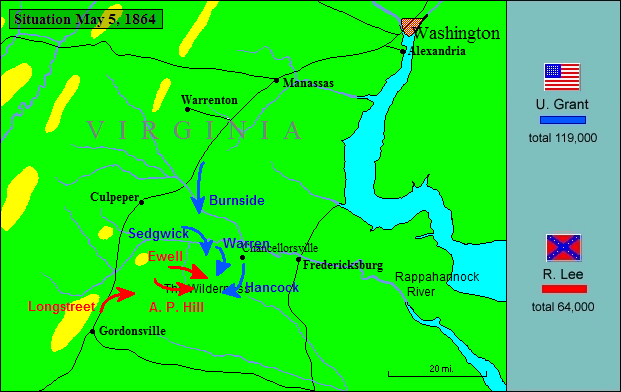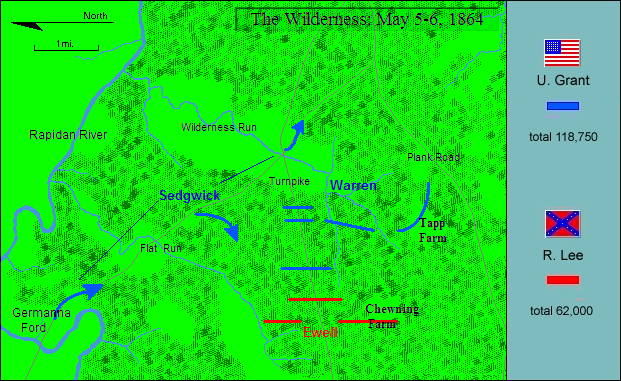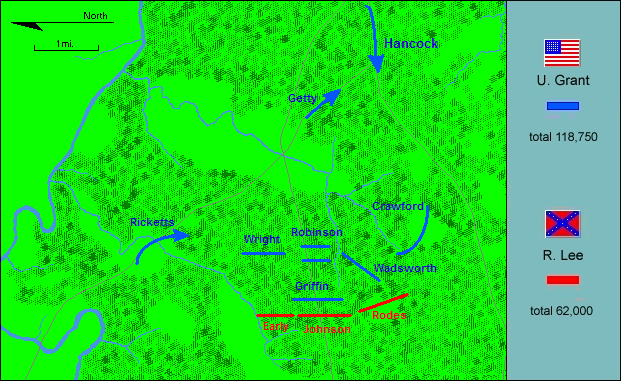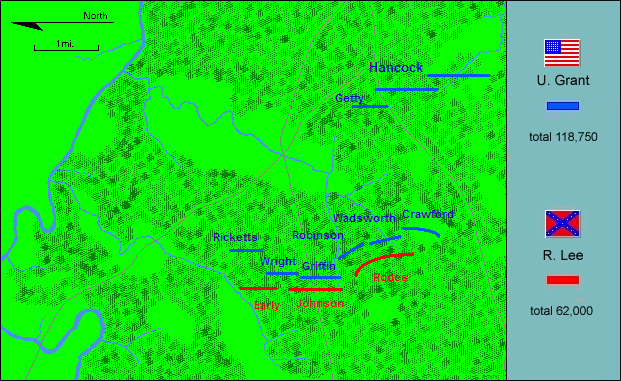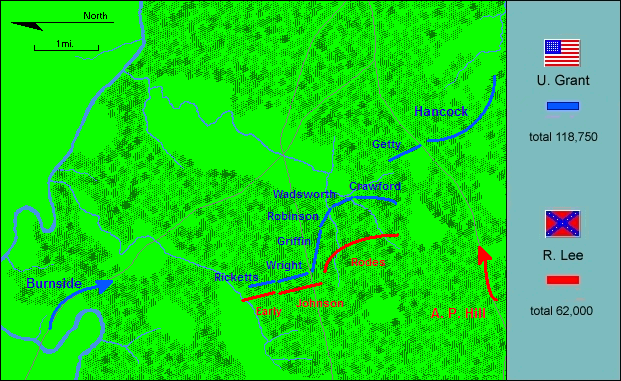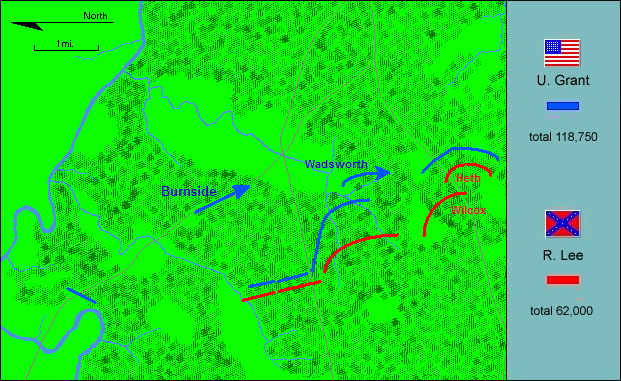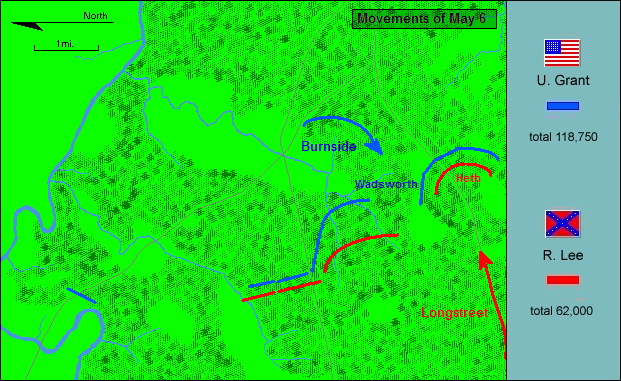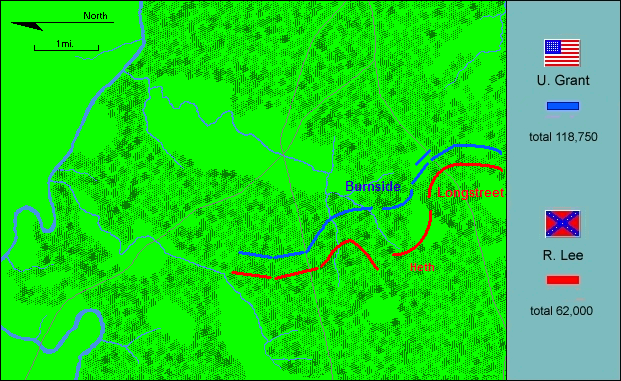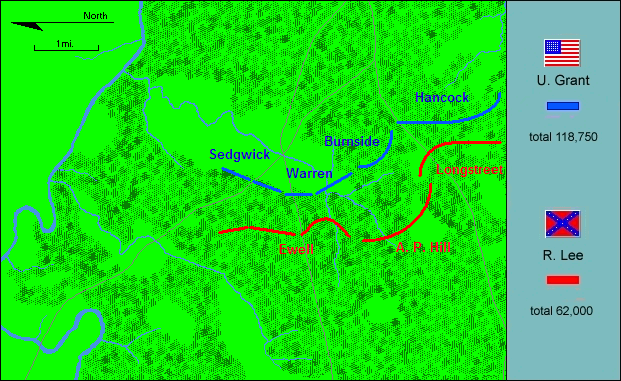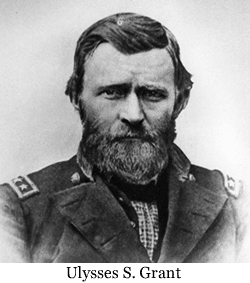
The next morning, May 5, the Army of the Potomac, technically still Meade’s army, moved south again in three corps–Hancock’s, Warren’s, and Sedgwick’s in that order. Bringing up the rear was Burnside’s independent (and generally ineffectual) IX Corps. Grant was going to be on hand every step of the way to see his intentions carried out. Robert E. Lee of course was unwilling to allow a much larger Federal army to pass through the fearful thickets of the Wilderness without a fight. With Longstreet still on the way, he sent Ewell’s corps on his left eastward down the Orange Turnpike and Hill’s corps on his right down the Orange Plank Road, meaning to strike Grant’s strung-out columns at right angles. Ewell’s advance collided with Warren’s corps near Wilderness Tavern and ignited what would be perhaps the most confused and bitter fighting of the war. Not a battle really, one thought, but “a blind and bloody hunt to the death, in bewildering thickets.” On Ewell’s front, the fighting simply surged back and forth, as brigades were broken into regiments, regiments into companies. In the furious smoky confusion, some officers tried to direct their attacks by compass across a tangled landscape with scarcely a distinguishing feature. On both sides, an outfit would advance, make progress, then be struck a savage flank attack by an invisible foe–or worse, by an invisible friend confused by the battle smoke and burning brush. To the south on Hill’s front, near the intersection of the Plank Road and the Brock Road, Rebels were having some success and threatened to drive through a gap between Warren and Hancock, but Hancock briskly counter-marched his men back up the Brock Road and pitched into the fight. The battle there blew up into what one remembered as “bushwhacking on a grand scale.” The Confederates were driven back bloodied and in disorder. As darkness drew on, the first day’s savagery slackened, falling off into fitful picket firing that lasted all night long. No one knows how many helpless wounded men were immolated in the burning woods.
In the grim darkness, Grant and Lee plotted their next moves. Lee, who had encountered and beaten a series of Federal commanders, had once remarked that eventually Lincoln would send a general he didn’t understand. That never happened. But now he was facing at last a commander who brooded about what he would do to Lee and not what Lee might do to him. Lee anticipated, correctly, that Grant would try again to turn his right. Accordingly, Lee intended to attack Grant’s left. But before Lee could throw his punch (Longstreet was still on the road), Grant threw his. On the morning of May 6, Hancock on the Federal left supported by James Wadsworth’s division from Warren’s corps on his right surged forward on a mile-wide front and fell with a shock on A. P. Hill’s men who had been mauled in the fighting the day before. (General Wadsworth himself would soon be added to the mounting number of the dead.) Hancock now drove the Rebels back up the Plank Road the way they came, more than a mile to a clearing around the shabby farm of the Widow Tapp. Lee’s right–and hence his whole army–was in mortal danger here, and Lee himself was in the clearing to see it. Hancock’s men held up to reform for one more hard blow, then started forward once again. Even as they renewed their advance, however, Longstreet’s corps was arriving on the field. A Texas brigade, Longstreet’s van, came into the clearing, and Lee, his blood up, wanted to lead the charge himself. The Texas boys would have none of it. Very well then, Lee allowed. Standing in his stirrups, he gave a wave of his hat and shouted: “Texans always move them.” One brigade was not likely to move a whole corps, but their attack, and the artillery fire that supported it, was so fierce that it stopped Hancock’s advance in its tracks. The price the Texans paid was frightful: two of every three were killed or wounded.
But Hancock was stalled, and, more than that, stalled with his left in the air. As difficult as it was to direct troop movement in that smoking jungle, Longstreet managed to get four brigades around to his right and south of Hancock by way of a hidden unfinished railroad cut. There they drove hard into the exposed Federal left flank, and soon the blue line buckled and broke to the rear. Longstreet, riding among the brigades to drive the attack home, rode into the confused crossfire of two Confederate brigades shooting at each other. Trying to untangle them, he was himself shot by his own men. A rifle ball tore through his neck and into his right shoulder, taking him out of the war for five months, not far from the woods where friendly fire had taken Jackson out of the war forever. Hancock’s men, meanwhile, were broken but not done fighting. They fell back a mile or so and rallied along the Brock Road which ran roughly north-south and at right angles to Longstreet’s advance. There they threw up an earth-and-log breastwork and awaited two assaults: Longstreet’s and the forest fire that was sweeping their way. The late afternoon saw fierce fighting on this line. But Hancock’s men firing from their own burning breastworks along with some help from Burnside’s corps turned back the assault and secured Grant’s left once more. The long day’s struggle left the combatants here, or rather the survivors, more or less where they started that morning.
On Grant’s right Georgia brigadier John B. Gordon had been trying to persuade his chief, Dick Ewell, that this flank was likewise vulnerable and ought to be struck immediately. But the last time Ewell had acted on his own discretion, his corps had been bloodily repulsed from the high ground at Gettysburg, and he was unwilling now to act without orders. At last, Gordon got Lee’s permission to attack, and his division’s initial success late in the day proved Gordon right. Sedgwick’s men were driven a mile rearward, but Uncle John was a fighter with an iron jaw. He might be hit but he was hard to take out. In the gathering darkness, he rallied his men, formed a new line, and checked Gordon’s advance. Had the attack been made earlier in the day, perhaps a truly crushing blow might have been struck, but the crisis on the Union right had now passed. Not every Federal thought so, however. One agitated brigadier galloped into Grant’s headquarters on a spent horse with the news that Lee was flanking them again and all was lost. “I am heartily tired of hearing what Lee is going to do,” spat the normally undemonstrative Grant. “Some of you always seem to think he is suddenly going to turn a double somersault, and land on our rear and on both our flanks at the same time. Go back to your command, and try to think what we are going to do ourselves, instead of what Lee is going to do.” Shortly thereafter, the fighting sputtered out in exhaustion on both sides.
It is said that Grant wept in his tent that night, and in truth there was full cause for tears. Of the vast array that had crossed the river on the sunlit morning of May 4, more than 17,000 were now dead or wounded or wandering in shock in the burning maze of the Wilderness. Add to these Lee’s 10,000 casualties. Even now the screams of those trapped in the fires echoed in the landscape of nightmare. On the face of it, Grant had been mauled as thoroughly as Joe Hooker before him, and Hooker had got back across the Rappahannock as soon as he prudently could. Back on the Peninsula in what must have seemed an age ago to the veterans, McClellan had spoken, perhaps more wisely than he knew, of the “moral responsibility” of the men who lead their fellows to such agony. Little Mac had aspired to the status of savior of the nation. Sam Grant had aspired to the post of mathematics professor at some small college. But now the immense burden of moral and military responsibility fell on Grant, a man who could not bear the sight of blood. At least two men divined with clarity the character of the former leather-goods’ clerk from Illinois. One was a soldier in the ranks from Maine, Elisha Rhodes, whose sweaty diary supposed: “If we were under any other General except Grant I should expect a retreat, but Grant is not that kind of soldier.” The other judgment belonged to the highest soldier in the Army of Northern Virginia, Robert E. Lee. “General Grant is not going to retreat,” he was convinced. “He will move his army to Spotsylvania. I am so sure of his next move that I have already made arrangements… so that we may meet him there.” Both divined aright.
In a sense Joe Hooker had been whipped last May in the thickets of the Wilderness before the battle had even been joined, the moment he surrendered the initiative to Robert E. Lee. Grant would do no such thing. He would try to turn Lee’s right once more, marching southeast again, this time to Spotsylvania, a crossroads town a dozen miles down the road. If he got there ahead of Lee, he would be closer to Richmond than the Confederates, and Lee would have to throw his army against Federal works no matter what the cost. Grant had told Lincoln before the campaign opened that no matter what happened “there will be no turning back.” The men in the ranks, however, didn’t know that. All day during May 7, they stood warily behind their works and wondered where their taciturn commander would lead them next. Most glumly expected a reprise of Hooker’s retreat last spring. After dark on the 7th, Warren and Sedgwick’s men were quietly pulled out of line and formed in column on the Brock Road and Orange Turnpike respectively. Warren’s men were a little surprised to find themselves marching south across Hancock’s rear, but most still supposed that they were simply marching down to get on the Plank Road that would take them east to Chancellorsville. From there, they believed, they would follow the wounded north to Ely’s Ford and back over the Rapidan. Thus, at the intersection of the Brock and Plank Roads came a discovery that revealed the character of both the Army of the Potomac and its commander: the column was headed south. Men who had been two days in savage battle began to cheer the man who would take them into more bloody strife. It took Sedgwick’s men a little longer to discover their destination since they took the pike all the way to Chancellorsville before they turned south, but their reaction was the same. “Our spirits rose,” one remembered. “We marched free. The men began to sing… That night we were happy.” The race for Spotsylvania Court House was on.

